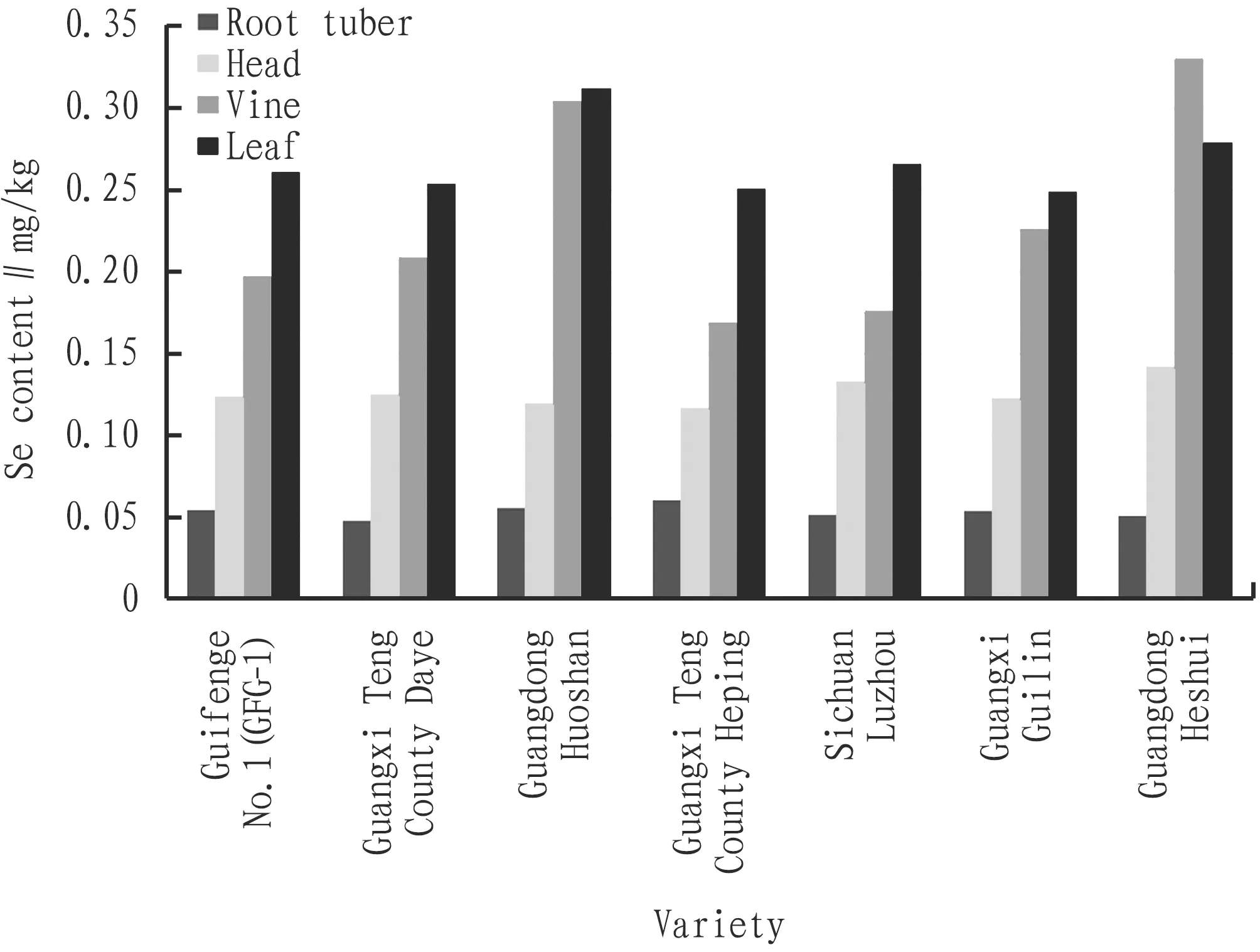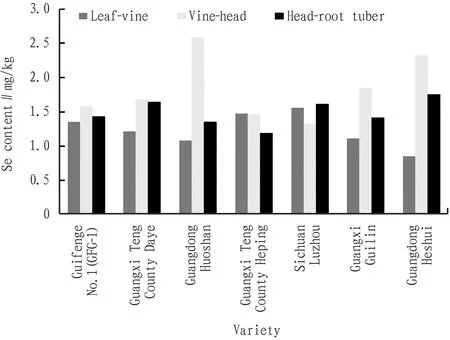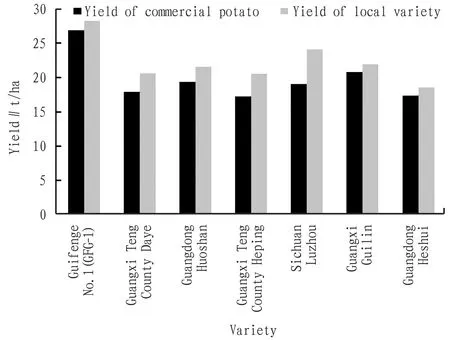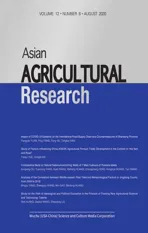Comparative Study on Natural Selenium-enriching Ability of 7 Main Cultivars of Pueraria lobata
2020-09-28KunpengOUYuanningYANGXueliWANGRishengHUANGChengchengFENGHonghuaHUANGYanWANG
Kunpeng OU, Yuanning YANG, Xueli WANG, Risheng HUANG, Chengcheng FENG, Honghua HUANG, Yan WANG*
1. Biotechnology Research Institute, Guangxi Academy of Agricultural Sciences, Nanning 530007, China; 2. College of Agriculture, Guangxi University, Nanning 530004, China; 3. Guangxi Teng County Institute of Agricultural Sciences, Wuzhou 543300, China; 4. Vegetable Research Institute, Guangxi Academy of Agricultural Sciences, Nanning 530007, China
Abstract [Objectives] To screen out the selenium-enriched Pueraria lobata varieties suitable for cultivation in Guangxi according to the natural selenium-enriching ability of 7 main cultivars. [Methods] Taking 7 main cultivars of P. lobata in different places as experimental materials, field cultivation was carried out on the selenium-enriched yellow soil in Shanglin County, Nanning City of Guangxi, to study the difference in selenium-enriching ability of different main cultivars and the comparison of selenium content in different parts, as well as the transport mechanism. [Results] Under the condition of soil selenium content of 0.78 mg/kg, the selenium content of the root tubers of the 7 main cultivars all reached the selenium-enrichment standard. The selenium content of a single root tuber of Heping Variety in Teng County, Guangxi was the highest, at 0.061 mg/kg; Guifenge No.1 was the second at 0.055 mg/kg, and the total selenium accumulation per unit area was the largest. The ranking of selenium content in different parts of the same variety was: leaf > vine > head > root tuber. [Conclusions] Guifenge No.1 has the highest yield and the largest total selenium accumulation, so it is the most suitable natural selenium-enriched variety for cultivation.
Key words Pueraria lobata, Selenium, Enriching ability, Comparison
1 Introduction
Selenium is a trace element essential to the human body, and it has anti-oxidation and anti-aging functions. Many human diseases (such as Keshan disease, Kashin-Beck disease,etc.) are related to the lack of selenium in the body[1]. According to statistical data, about 72% of counties (cities) in China are deficient in selenium to varying degrees, of which one-third are severely deficient. There are more than 300 million people with insufficient selenium intake, which seriously affects people’s lives and health. Guangxi is a selenium-rich region. Only the four regions (Nanning, Qinzhou, Beihai, and Guigang) showed that the area of selenium-enriched soil reached 2.120 8 million ha, showing Guangxi is currently a large concentrated selenium-enriched soil area in China[2]. Besides, large areas of concentrated selenium-enriched land have been discovered in the western, northern and eastern regions of Guangxi, which provides Guangxi with good natural conditions and resource advantages for the production of selenium-enriched agricultural products and the development of selenium-enriched industry[3]. At present, the absorption and enrichment of selenium by crops and the study of selenium’s biological effects on plants have received wide attention[4]. In order to increase the selenium content of food, exogenous selenium supplement technology and related products have been continuously developed and applied. According to some studies, although natural selenium enrichment is limited by the natural selenium content in nature and the physical and chemical properties of the soil, natural selenium enrichment conforms to the laws of nature and can maintain the ecological balance of nature[5]. Most of the existing studies onPuerarialobatais in cultivation technology, component research, medicine and food development, product processing,etc., while the research on selenium enrichment is less and mostly concentrated on wildP.lobata. He Hanjieetal.[6]studied the effects of low-concentration sodium selenite on the growth ofPuerariaphaseoloideshairy roots and the biosynthesis of isoflavones. Liu Huazhongetal.[7]analyzed the mass fraction of dry matter selenium in Enshi wildP.lobataroot tuber, and believed thatP.lobatais suitable for the development of various selenium-enriched foods and medicines, and is an ideal raw material for health care products[7]. In academic circle, there are few studies on the selenium-enriching ability of artificially cultivatedP.lobat. At present, the mechanism of selenium enrichment inP.lobatais still unclear. In this experiment, we studied the selenium-enriching ability ofP.lobatain different places under the condition of selenium-enriched soil. According to the content of selenium in the main parts ofP.lobata, we explored the relevant selenium-enriched transport mechanism, and finally we screened out the selenium-enrichched and high-yield varieties suitable for planting in Guangxi on the basis of the yield and marketability.
2 Materials and methods
2.1 Planting placeThe experiment was carried out at theP.lobataplanting base in Shanglin County, Nanning City, Guangxi from April to December 2018.
2.2 Experimental materialsWe collected sevenP.lobatavarieties from Guangxi, Guangdong, and Sichuan provinces, including 4 varieties in Guangxi: Guifenge No.1 (GFG-1), Guangxi Guilin variety, Guangxi Teng County Daye variety, Guangxi Teng County Heping variety, two in Guangdong: Guangdong Huoshan variety, Guangdong Heshui variety, and one in Sichuan: Sichuan Luzhou variety.
2.3 Experiment methodsIn this experiment, a total of 21 experimental plots were set up, and 3 non-adjacent repeated tests were performed for each local varieties. The planting area of each plot was 5 m×5 m=25 m2, and the spacing between each plot was 0.9 m; 3 rows were set in each plot, the spacing was 1.7 m, and each row was planted with 10P.lobataseedlings.
2.4 Planting managementP.lobatawas managed in accordance with the traditional planting methods ofP.lobatacultivation, and the management techniques and measures during the planting period are the same.
2.5 Data recordsP.lobatawas planted in April 2018, photosynthetic characteristics were measured in November, and samples were taken in December. Data were recorded and collected. At the same time of sampling, one row of the same variety was selected from each plot for yield measurement, and the yield per hectare of a single local variety was calculated by measuring the yield of different repeated plots; from different local plants, 5 plants with the same growth were selected, and the soil at the same location was analyzed and tested, and the selenium content in the leaves, vines, heads and root tubers of the plants, as well as the tuber starch and puerarin content were determined; the yield of tubers and commercial potatoes was calculated.
2.6 Determination of selenium contentFor the determination of the selenium content in each part of the plant, referred to the method in national standard method (GB 5009.93-2010).
2.7 Related calculationsTransport coefficient (TC)=Ratio of selenium (mg/kg) of the various parts ofP.lobata. Total selenium accumulation in root tubers=Selenium content in root tubers (mg/kg) × Yield of root tubers (kg).
3 Results and analysis
3.1 Se content of root tubers in different placesThe root tuber is the edible part ofP.lobata. As shown in Fig.1, although the Se content of the root tubers in the seven different places had little difference (the difference was in the range of 0.048-0.061 mg/kg), according to the selenium-enrichment standard (0.02-0.20 mg/kg) of Guangxi potato agricultural products, all of them have reached the standard for selenium-enriched food. Specifically, the highest Se content in root tuber was from Guangxi Teng County Heping variety at 0.061 mg/kg, and the lowest was from Guangxi Teng County Daye variety at 0.048 mg/kg. Although they were varieties in the same region, the difference between the them was 0.013 mg/kg. The Se content in root tubers of Guifenge No.1, Guangdong Huoshan variety, Sichuan Luzhou variety, and Guangxi Guilin variety was 0.055, 0.056, 0.052 and 0.054 mg/kg, respectively. Although there were large differences in the 4 regions, there was no obvious difference in selenium content due to differences in regions.
3.2 Se content in each parts of different local varietiesFrom Fig.1, it can be seen that the Se content in tubers, heads, vines, and leaves ofP.lobatavarieties in 7 different places showed the same distribution pattern: leaf > vine > head > root tuber. Specifically, the highest Se content of root tubers was 0.061 mg/kg; the Se content of head was about 2-3 times that of root tubers, the highest was 0.142 mg/kg of Guangdong Heshui variety, and the lowest was 0.117 mg/kg of Teng County Heping variety, there was no significant difference in the Se content of head; the Se content of vine was about twice that of head, the highest was 0.330 mg/kg for Guangdong Heshui variety, and the lowest was 0.169 mg/kg for Teng County Heping variety in Guangxi, and the difference was 95.27%; the Se content of leaves was about twice that of head, the highest was 0.312 mg/kg for Guangdong Huoshan variety, and the lowest was 0.251 mg/kg of Teng County Heping variety in Guangxi, there was no significant difference in the Se content of leaves from different local varieties. The Se content in the same part planted in different places showed large differences. For example, the Se content of vine from Guangdong Heshui variety was 0.33 mg/kg, which was 1.95 times that of Teng County Heping variety in Guangxi; but the Se content in root tubers was 0.051 mg/kg, only 0.84 times the latter.

Fig.1 Se content in each part of different Pueraria lobata varieties
3.3 Se transport coefficient of differences parts of different local varietiesFrom Fig. 2, it can be seen that the leaf-vine Se transport coefficient ofP.lobatain different places was in the range of 0.85-1.60, the highest was 1.56 of Sichuan Luzhou variety, and the lowest was 0.85 of Guangdong Heshui variety. The difference between the two reached 1.84 times. The vine-head Se transport coefficient of differentP.lobatavarieties was in the range of 1.33-2.60. Guangdong Huoshan variety and Guangdong Heshui variety were the two varieties with the highest vine-head transport coefficients, 2.58 and 2.33, respectively. The leaf-vine transfer coefficient of other varieties did not exceed 2, and the lowest was 1.33 of the Sichuan Luzhou variety. The Se transport coefficient of head-root tuber of different local varieties was in the range of 1.15-1.75, the highest was 1.75 of Guangdong Heshui variety, and the lowest was 1.19 of Teng County Heping variety, and the difference between the two was 47.06%. The enrichment coefficient of different local varieties was in the range of 0.120-0.140, and the difference between varieties was not significant, the highest was 0.142 for Guangdong Huoshan variety, and the lowest was 0.125 for Teng County Daye variety.

Fig.2 Se transport of different Pueraria lobata varieties
3.4 Comparison of yield of root tubers between different local varietiesFrom Fig.3 and Fig.4, it can be seen that the seven different local varieties have big differences in yield per hectare, commercial potato yield and commodity rate. Specifically, the yield per hectare and commercial potato yield of Guifenge No.1 reached 28.41 and 27.02 t/ha respectively, and its commodity rate reached 95.1%. All three indicators were the highest among seven varieties; the second was Guangxi Guilin variety with the yield per hectare and the commercial potato yield reached 21.99 and 20.82 t/ha respectively, and the commodity rate was 94.7%. Although the commodity rate of Guangdong Heshui variety reached 93.3%, the yield was only 27.61 t/ha, which was the lowest in the experiment. The yield of Guifenge No.1 (GFG-1) dropped by 52.74%. The lowest commodity rate was Sichuan Luzhou variety, with only 78.8%, which was the only variety below 80%.

Fig.4 Commodity rate of different local varieties
3.5 Se content of root tubers in different local varieties
Combined with the analysis of Fig.1 and Fig.3, the Se content in root tuber of Guifenge No.1 (GFG-1) was 0.055 mg/kg, which was slightly lower than the highest content of 0.061 mg/kg in Teng County Heping variety, but because of its highest yield per hectare, it was still higher than Teng County Heping variety by 38.16%. Through calculating its total Se accumulation in root tuber and commercial potato Se, it reached 1 562.55 mg/ha and 1 486.5 mg/ha, respectively, while Teng County Heping variety was only 1 254.6 and 1 052.1 mg/ha, therefore, Guifenge No.1 (GFG-1) was the variety with the highest Se content in root tubers of all the tested varieties. In addition, the two varieties with lower total Se accumulation value in root tuber and total Se accumulation value in commercial potato were Guangxi Teng County Daye variety and Guangdong Heshui variety. Due to the low Se content of single root tubers of the two varieties, their yield and commercial potato yield were also the lowest, total Se accumulation values were 990.9 and 948.6 mg/ha, respectively; the total Se accumulation values of commercial potatoes were 860.4 and 885.15 mg/ha, so the total Se accumulation values and the total Se accumulation values of commercial potatoes were lower in the seven main cultivars. There was no significant difference between the total Se accumulation in root tubers of the other four varieties and the total Se accumulation in commercial potatoes.

Fig.3 Yield of different local varieties and commercial potatoes
4 Discussions
The seven varieties Guifenge No.1, Guangxi Teng County Daye variety, Guangxi Teng County Heping variety, Guangdong Huoshan variety, Guangdong Heshui variety, and Sichuan Luzhou variety were from different regions, but the difference in the selenium enrichment ability of single plants. Under the condition of 0.78 mg/kg natural selenium-enriched soil, the Se content of the root tubers of the seven main cultivars ofP.lobatawas 0.055, 0.048, 0.056, 0.052, 0.054 and 0.051 mg/kg, all meet the selenium-enrichment standard of 0.02-0.20 mg/kg (fresh sample) for potatoes specified in DB35/T1061-2014 issued by Guangxi in 2014, indicating thatP.lobatais a selenium-enriched crop.
Due to the difference in Se transport coefficient of different varieties, the ratio of selenium-enriched Se content in the root tubers of different varieties is inconsistent with that of the non-selenium content in various parts above the ground. For example, Guangdong Huoshan variety has the highest Se content in leaf, Guangdong Heshui variety has the highest Se content in vine, but the Se content in root tubers of both is not the highest; on the contrary, Guangx Heping variety with lower Se content in leaf and vine has the highest Se content in the root tubers. However, the same main varieties ofP.lobatain Guangdong show higher selenium content in leaves and vines; the same main varieties ofP.lobatain Guangxi have the Se content in leaves and vines significantly lower than that of Guangdong varieties, but Se content in root tuber is slightly better than the latter. Therefore, when selecting selenium-enriched varieties, we should focus on selecting varieties that can retain more selenium in the root tuber, rather than transport more to the ground. Besides, the new Guifenge No.1 variety is derived from the excellent strains of Teng County Heping variety[8]. It has inherited a good selenium-enrichment ability and also showed its excellent high-yield performance.
In this experiment, the samples were collected in the harvest period. Through analysis and detection, the results of the Se content of different parts are in the order of: leaf > vine > head >P.lobatabark > root tuber, which is consistent with the research result on potato[9]. The Se content of each organ of potato is leaf > stem > root tuber at maturity stage.. According to the transport principle of selenium in plants[10-11], under the conditions of photosynthesis,P.lobataaccumulates selenate directly from the roots through the ducts of the vines into the leaves, assimilates in the leaf chloroplasts, and retains most of the selenium in the vines and leaves[12]. The selenium transport coefficient reflects the distribution of selenium in theP.lobataplant to a certain extent, but the migration of selenium in theP.lobataplant has not been fully studied yet, so it is necessary to make further research.
杂志排行
Asian Agricultural Research的其它文章
- Impact of COVID-19 Epidemic on the International Food Supply Chain and Countermeasures of Shandong Province
- Study of Factors Influencing China-ASEAN Agricultural Product Trade Development in the Context of "the Belt and Road"
- Comprehensive Evaluation on the Level of Agricultural Economic Development in Hubei Province Based on Principal Component Analysis
- Effect of Foliar Application of Selenium Fertilizer on Yield, Selenium Content and Heavy Metal Contents of Waxy Maize
- Effects of Applying Trace Clements on Yield and Quality of Flue-cured Tobacco Cuibi-1
- Analysis of the Correlation between Middle-season Rice Yield and Meteorological Factors in Jingdong County from 2009 to 2016
